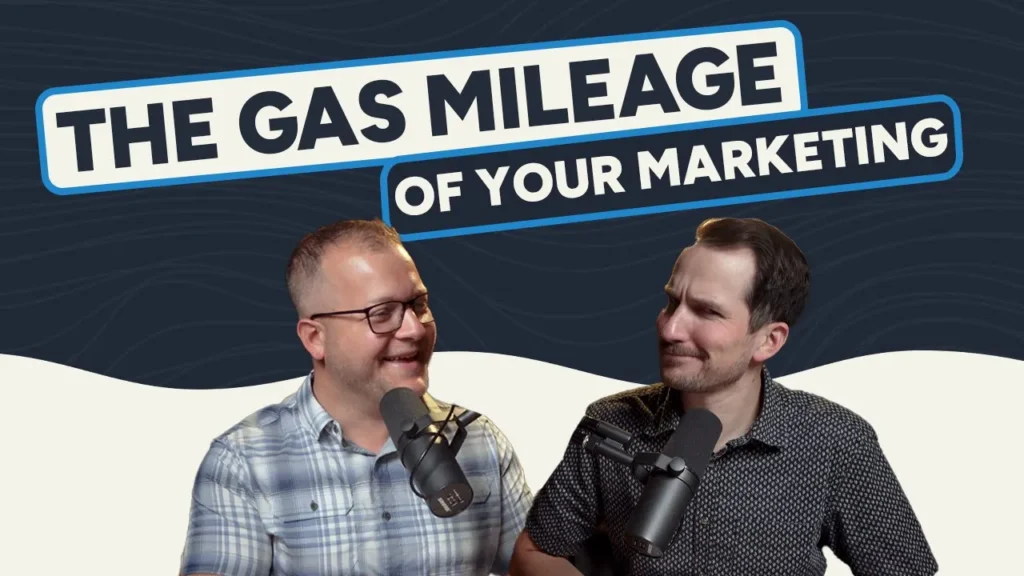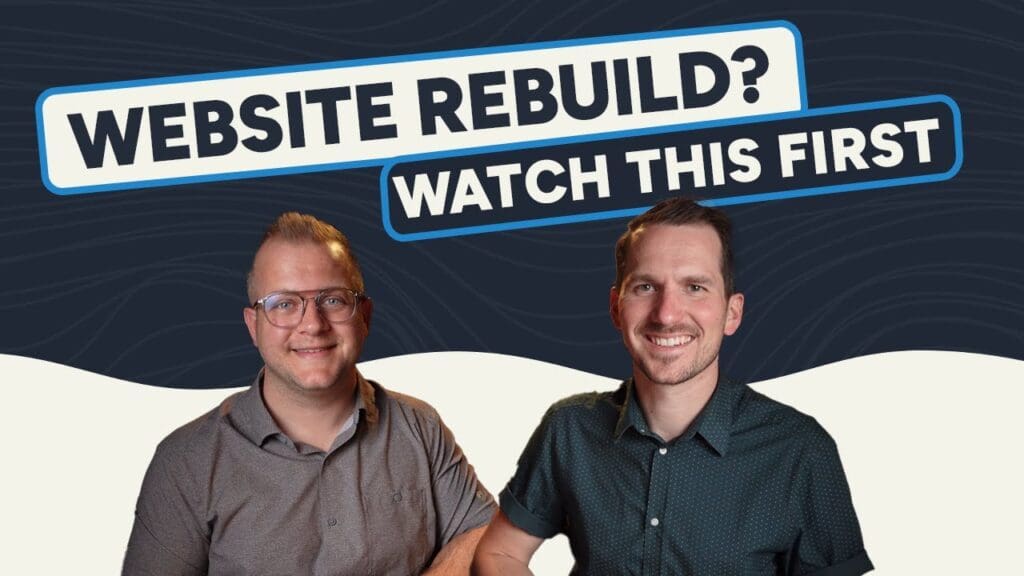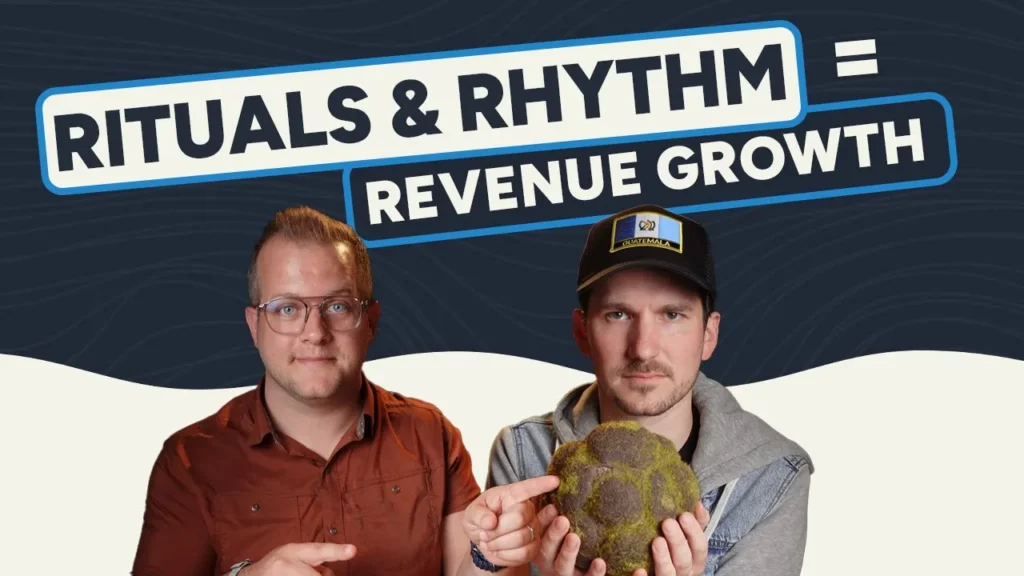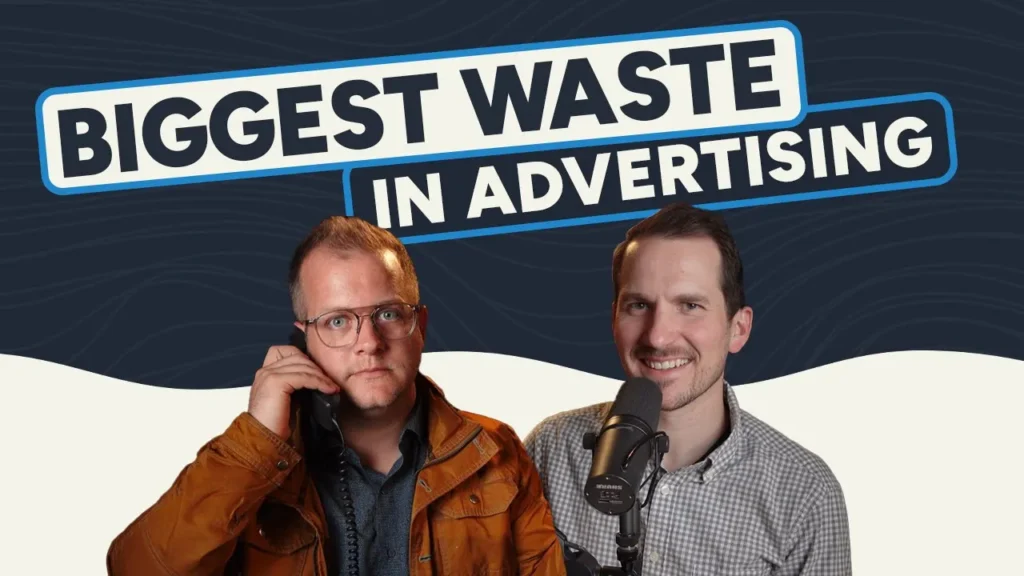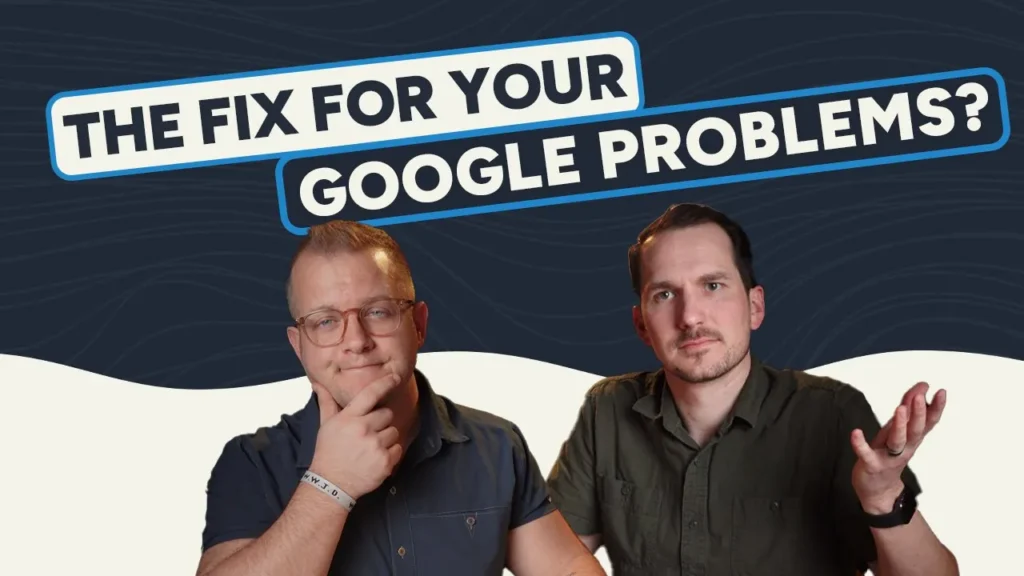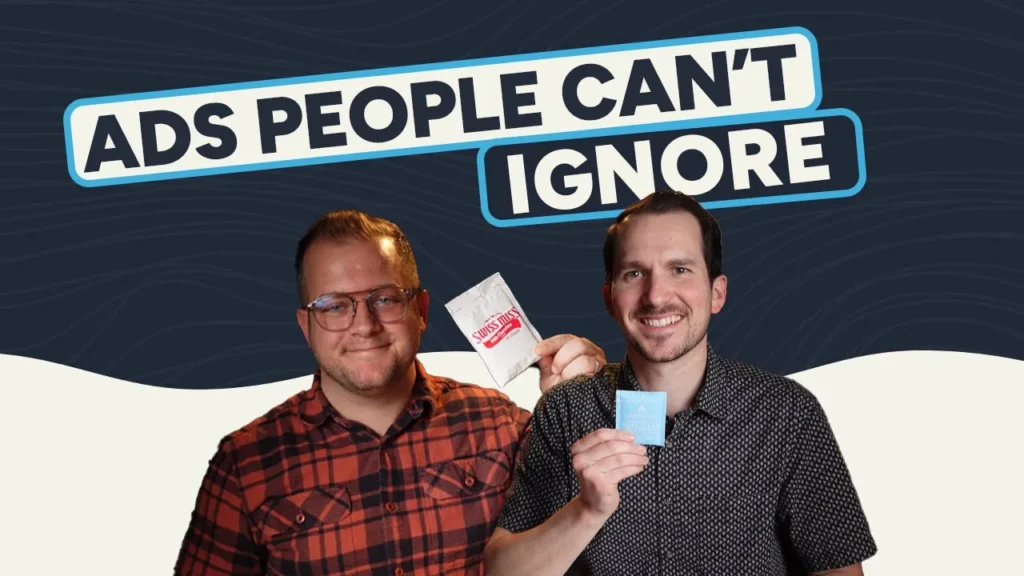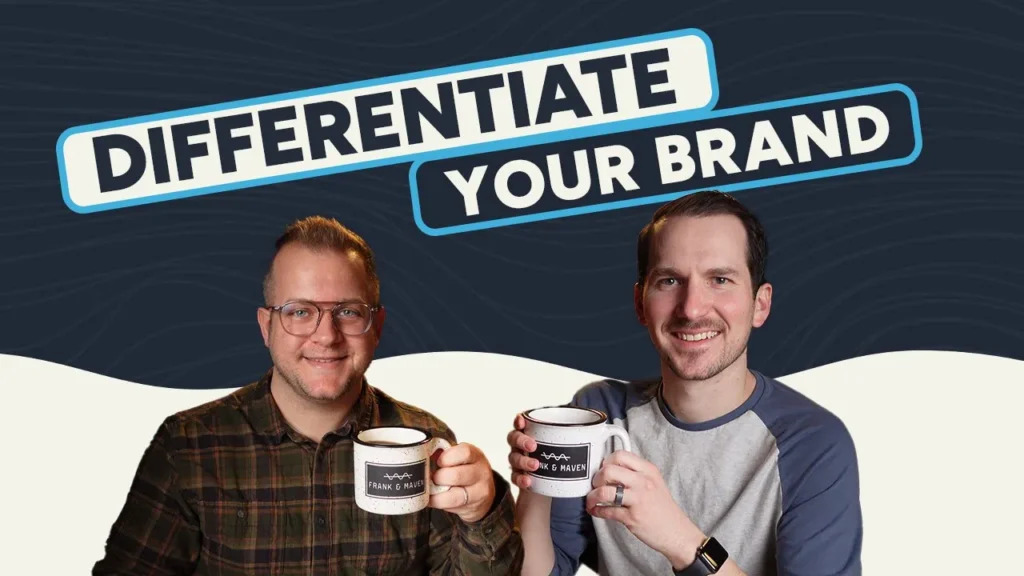Can Social Posting Replace Your Ad Budget?

00:00 Intro
01:27 Should This Replace Your Budget?
04:51 This Is The Cheapest Way To Show Your Ad To Everyone
14:11 Is Your In-House Media Team Doing This For You?
This Episode Hosted by:
Recent Episodes:
What Are CPMs? The Gas Mileage of Your Marketing
Rituals & Rhythm = Revenue Growth
Get New Episodes In Your Inbox:
We'll be back every Monday answering your real life marketing questions!
Listen to Audio Only:
Keep Sharpening Your Marketing Skills With The Maven Marketing Podcast
What Are CPMs? The Gas Mileage of Your Marketing
CPMs are the great equalizer of marketing media. To make great decisions, you need to know how…
Rituals & Rhythm = Revenue Growth
Culture eats strategy for breakfast—and in this episode, Brandon Welch and Caleb Agee show you why rhythm…
The Single Biggest Waste In Advertising
You might think the biggest waste in advertising is bad creative, weak targeting, or outdated platforms. But…
IDKWNTHTB – Keep Showing Up!
Every business owner hits the wall. You launch the campaign, tweak the copy, show up every week—and…
Stop asking, “How did you hear about us?” (do this instead)
It’s lurking… tucked into a form on your website or maybe it’s a part of your sales…
IDK Who Needs To Hear This But: You Need To Fill One Glass At A Time
FREE MARKETING AUDIT: MavenMarketingAudit.com Get a copy of our Best-Selling Book, The Maven Marketer Here: https://a.co/d/1clpm8a Our…
How to Immediately Differentiate Your Brand
There are no more unique value propositions. You could invent the next big thing and you’ll have…
Brandon Welch 0:00
It’s a bad signal for any buyer to come across you in your last post, to be like six months ago, or even six weeks ago. Like there’s a different use and a different function of social media that plays a part into the buyer journey. If they see you actively engaged, they see pictures of your work, if they see testimonials, if they see you doing fun, cool things, that adds to that bond and that trust in you.
Welcome to the Maven Marketing Podcast. Today is Maven Monday. I’m your host, Brandon Welch, and I’m joined by Caleb skinny stand, AG, what? We had a equipment malfunction moments ago? Yeah. We lost a gator. Frameworks,
Caleb Agee 0:40
yeah, my
Brandon Welch 0:41
microphone stand to gravity.
Caleb Agee 0:43
You gave out. They gave out.
Brandon Welch 0:45
It went kaput and now Caleb’s got a tiny mic stand. It’s
Caleb Agee 0:49
just a theory, but gravity shows up again. It’s
Brandon Welch 0:52
not the size of the stand, it’s how you use it. Today, we are doing what we do every day, every week here on the Maven Marketing Podcast, hoping to eliminate waste and advertising, grow your business so you can achieve the big dream. And I am back. Caleb, held on the fort with many distinguished guests amongst Frank and Maven team. Uh, thank you, yeah. Put out some wonderful, wonderful,
Caleb Agee 1:15
happy to help. It’s fun to fun to do. Yes, your chairs. It’s a good chair over there?
Brandon Welch 1:20
Yes,
Caleb Agee 1:21
the left side’s All right.
Brandon Welch 1:23
Do we get your other side? Yeah, we did see my my other side. Okay, well, we’re gonna go to the other side of marketing today and talk about social media. And I probably, since the beginning of my career, this has kind of been a thought with the idea of social media posting. Where does it belong in the mix? How powerful is it? Can I grow my business with just organic social media posting? And I think we all know now that, you know, paid social media is way more of a thing than it was 510, years ago for a local business. It’s been that way for online for a long time, but we’ve had some recent good questions about, can I replace part of my paid strategy with social media? Organically? Organic, organic, quote, unquote, free media? Yeah, we’re gonna break down two case studies of where that may or may not be a good idea, and the big idea around any thing where we’re talking about media and advertising in general. The thing that levels everything is, how many people am I reaching, and how much do I have to pay to reach those people? That’s right. So let’s not get into opinions about what you do, or maybe what I do as a human being walking around what we think the world is doing. It’s not about, you know who is doing what, necessarily, as much as it is the objective truth about if you wish to bond people to your business so that they one day transact with you, how many people are you reaching to do that with your message, right? Yeah,
Caleb Agee 2:56
yeah. And I think it’s good to also keep in mind something we Carter and I did an episode on I don’t know how many months ago, but it was about reaching your organic audience on social medias and how much those algorithms have changed. We’re not going to talk about that much today. We’re going to look at just the base numbers, but these numbers are reflective of how often your posts as a business actually end up in people’s feeds. And so just keep that in mind. Go listen to that episode. We’ll link to it in the notes right
Brandon Welch 3:29
about now, Nate just popped that episode up on the screen. You can click it if you are interested in just the state of social media. If
Caleb Agee 3:37
we were really cool, we could point to, you know, go pop. Yeah, yeah. I think Nate
Brandon Welch 3:41
just did that. It happened in the future. He did it. So we’re gonna keep in mind it’s not about what media is, quote, unquote the best, because at the end of the day, media is mostly just a vehicle to deliver your message, and the degree of impact relies mostly on how many people you’re reaching, right? There’s some other nuances later, but we’re not gonna go into those weeds just, let’s just break it down to full on, like, how many people saw my message? Yep. And so let’s compare what it would take in a social, organic posting manner to reach as many people as other advertising platforms. Yeah. And what we may find is that we can do it cheaper, doing that, or we may find that we can’t. So two case studies. We pulled these from real, live consults we’re doing right now. One is a home improvement company. Actually, that’s the second one. The first one is, is a enthusiast brand. We’re just gonna call them an enthusiast retailer. They have a, you know, a product that reaches people that have a really strong affinity for this. They’re
Caleb Agee 4:47
selling across the country, across the world, in some cases, probably, yes,
Brandon Welch 4:51
when we’re talking about how many people we reaching in traditional media, we measure that with the rating companies like Nielsen. You’ve probably heard of that. What it says Neil. Sudden rating. That’s the companies that go out and scientifically measure how many people watched at any given hour a day on any given station. And so they come back with reports that say, Hey, this is where people if they’re watching TV, this is where they’re watching, and this is how many people are watching at any given time. Okay? And with print, there’s other surveys and ways they measure that audience, circulation and all of that, yep. With billboards, there’s other ways to measure that by, like, how many traffic, you know, cars drive by that billboard? Okay, online, of course, it’s measured digitally, like the ad server just says, I showed this ad this many times on this many pages. And so that’s just a foundational thing to say. There are, there are ways of measuring objectively what each of these medias do. And each time somebody sees your message, we’re calling that one impression. If you’ve been in advertising sales, or if you’ve been sold advertising for any amount of time, you’ve heard the word impression, yeah. And just to, just to clear out any jargon or confusion when we say impression, that just means somebody saw your ad, yep, or heard it, if it’s radio, right set of eyeballs, set of eyeballs, or a set of ears, or maybe both. But we’re not going to go into which one of those is better visual or audio. We’re just going to go into sheer reach, just for a baseline comparison. So that’s one impression, and a very common ratio you can use to compare one media versus the other is called cost per 1000 impressions, right? I’ve heard the term CPM. Yep. They call it CPM because somebody who was Latin inventing that term used a Latin M is milli, yeah, cost per milli, 1000s. Okay, yep, but we won’t go into that just just, you need to know that the common way to measure that is, how much did it cost me to reach 1000 people? Or, realistically, what that actually means is, how many, how much did it cost me for my ad to be seen by 1000 times? Yeah,
Caleb Agee 6:51
and we’re about to show you this, but this is the great leveler for all medias. Yes, when you are looking at digital, print, TV, radio, social, paid social, all of these can be leveled with CPMs, yes.
Brandon Welch 7:07
And you can say, What just out in the wild? Like, what’s the most efficient media you want to ask that person selling you the media? Or look in the ad dashboard, if you’re talking about like Facebook, and say, cost per 1000 CPM is a measure, is, like, a is, like, a reportable number that any platform or ad rep should be able to give to you. That’s right. So it’s like, the gas mileage of your media Some, yeah, some medias are big, you know, trucks that aren’t efficient. Some medias are Priuses, and they go a long ways on a little, little bit of gas, yeah? So a lot of media that we talk about on this show is in the category of what we call tomorrow media, because for most of the companies that we’ve grown to big, big, big amounts, we’re building brands for them. We’re building a bond and a familiarity with him, familiarity. I did it. You came out. It almost crashed. Remember familiarity with him, with 1000s and 1000s and 1000s of people. Okay, so we tend to lean into medias that are really good at reaching lots of people. And I’m just going to give you some of those. We’re going to use CPM as the measurement of, sort of their gas mileage, if you will. So broadcast TV today in most markets, on on like local news and things like that, you’re paying on average, five to $10 per 1000 times your ad was seen. Okay, average local radio station is more like 10 to $20 per 1000 times your ad was heard or seen. Average billboard is actually more like three to eight in a high interesting in a high traffic area. Yep. Magazines tend to be 20 to 60. If it’s a really specialized magazine, it might be higher than that. If it’s a more of a broad magazine, magazine that gets a lot of you know, lot of print, a lot of copies circulation, thank you. It could be a little lower than that, but 20 to 60 localized Facebook campaigns typically are 20 to $30 ish, if you were paying Facebook to to spread them out now with a higher targeting yes on it for for the sake of owner operated companies who are listening right now, right? Yep, if you’re doing Facebook nationally, it can get more efficient than that, but there’s nuances to that. So just giving you some ranges for a comparison, YouTube can be as low as, you know, $10 we’ve actually seen some really good efficiency in YouTube lately. I think if you are not skilled in that platform, you could probably expect more like 20 to 30. But I just gave you a range of like, broadly, what, what efficient factors are involved in each medias, okay, generally, the more targeted you go, the more tar you know, more parameters you put on I want to reach, you know, very, very specific people, the smaller that audience is, and therefore the the more expensive that platform is. So like OTT or Hulu or a lot of people that say, you know, I only watch. Search, TV, online. Those are really small audiences, comparatively still. They one day. They may not be right now they are, yeah, and those are more like $40 per 1000 to, I’ve seen as high as 70 or 80 per 1000 to reach those audiences. Yes, the most expensive CPM, I’m aware of that we actually do use, but it’s very, very, very expensive, is what it’s Google ads. Google Search Ads. Search, Search Ads. Yeah, yeah. The smallest amount of people, the smallest audience, is the people looking for you right now, yeah. And that’s
Caleb Agee 10:27
a today, that’s that big, expensive truck that gets, like, four miles a gallon, but it has a very specific use, yes, you know. And then in this case, we use Google search for today customers, yes, which is why we’re willing to pay a premium. Because you’re catching somebody right at the finish line, right? You are always going to pay more to catch them right at the end. Yes, you’ll pay a much less. You heard all those other numbers that are a lot smaller when you’re talking to them long before the sale.
Brandon Welch 10:55
An average CPM for our search campaigns is, like, $500 plus, like, it’s it’s high. Okay, so point is, you’re not reaching a lot of people on those areas, but they may be higher value people, okay, but when it comes to replacing your ad spend with free social media, okay, that’s the question being asked. We have to ask again, how many people are we reaching, and what are we paying to produce that content that reaches them? Right? Yep,
Caleb Agee 11:18
and a lot of, a lot of times, the production of that content happens in different ways. Right? You might have in house people. You might have a social media person in your in your building, or a couple, or something like that. It might be your time. It might be you, the owner, the marketing director. It might be also you might be outsourcing it an agency, freelance, freelance, personal kit, or
Brandon Welch 11:40
whatever you’re paying 500 bucks a month or whatever to make your stuff. So there is a cost to doing it, at least in the time factor. Okay, if you are a person who’s prolific and can just entertain and, you know, immediately create content without a whole lot of thought, congratulations, you’re a very, very, very rare person, and you might be able to leverage it better than company who doesn’t have that skill set. That’s right, I think it goes without saying, but Facebook only. We’re using Facebook, but we’re putting Instagram and Tiktok and any of the other platforms in that realm. They only show your ad to lots and lots of people if they deem it to be entertaining. And what we call, you know, viral as a viral nature to it. It’s gonna it’s going to be more than just about your business. You’re going to be yep in demand, enough that people want to actually naturally watch it
Caleb Agee 12:32
Yep. So they test it a little bit in a few people’s feed. And if those people engage with it, watch it, click on it, whatever that looks like. Facebook goes, Oh, this seems like a good a good piece of content, and they’re gonna put it in a few more and then that’s when that virality starts stacking. And all of this happens in real time over the course of the first 2030, minutes that your post goes out. We
Brandon Welch 12:54
have a client that is that just is naturally and hilariously, just present all the time. He’s funny. You put a camera in front of him and he’s gonna be funny. Okay? His stuff gets hundreds and hundreds of 1000s of views without a whole lot of steam, just by simply being himself. Okay? But I will say he’s actually not talking about the product at all, and it’s in very few people’s interest to sit and listen to your product pitch. Okay, that’s right. So Roy said it best, I think when he said advertising as a as a tax we pay for not being remarkable. So step one, you have to be remarkable. But let’s just assume you have that factor of great content. You have great content, you can produce it. Let’s look at some real numbers here. So case study, going enthusiast brand with an in house team. So let’s say you’re a brand that people, you know, naturally want to follow, and they like the product, and you’re producing content that, like, serves a lifestyle, maybe not a maybe not a service business, or, like, a commoditized type business. Think outdoor gear, think, you know, maybe a specific type of automobile or recreational thing, or maybe a music store or some sort of lifestyle hobby based thing that’s, yep, that’s the realm of what we’re talking about here. Yeah.
Caleb Agee 14:13
So this, this company, has a larger footprint, larger organization. Yes, they’ve actually got two people producing content, yes, in house, full time, full time salaries, they are, they’re working. They’re posting probably almost daily, if not daily, and with both videos and graphics, videos, graphics, and I think they even have, like a little, a little show, right, that they’re producing on the regular. So yes, we’re talking about lots of content,
Brandon Welch 14:41
kind of like the Maven Marketing podcast. Hey, yeah, yeah, we could talk about that. So they’re doing it to a high level. Okay, yes. And the question posed to us was like, hey, with what I’m paying this team to do this, couldn’t I just buy a bunch of ads, and couldn’t I maybe reduce. Reduce my overhead and then produce, you know, either reduce my overhead or or should I spend more money? Or should I produce more content? Was actually the real question, yep, should I stop doing this content? Because it’s costing me a lot. That’s, yeah, it’s actually a question that was posed. And so we said, okay, about how many times were your posts and videos and stuff seen in the last year? Yep, impressions, which is an impression, right? And they calculated a few things, and was around about 8 million impressions. Isn’t that wild? It’s
Caleb Agee 15:33
a lot of impressions.
Brandon Welch 15:37
That’s a lot. That is a lot. And so you might be asking, How do you know it’s a lot? Well, we say, what would we have to pay for that if we weren’t remarkable, if we didn’t have this team, what would have to pay for that in the real world? Let’s just say if we did it on TV or with paid YouTube ads, or with paid Facebook ads or some sort of other media, right? Yeah, if we weren’t reaching 8 million people by our remarkable content, how else would we do it? Because you can imagine reaching some, you know, your stuff being seen 8 million times, that’s going to have a business effect. Yeah, that’s, that’s for sure. It’s no small piece of noise you’re making there. So, so we use the average, like a really, actually, a low average. We’re being very generous and conservative, like, just to say, if you were paying $10 cost per 1000 across your entire ad budget to get 8 million impressions. And there’s a little tool that’s about to pop up now, and you can click this and do this with your own media. You could go to your social posting dashboard and look at the last year or the last 30 days, and say about how many people are my posts reaching? Okay, we said, if you were reaching 8 million people in the real market. To do that with advertising, you would pay at least $80,000 to make that happen. Yeah,
Caleb Agee 16:45
we took a $10 CPM, just for ease of the numbers you’re listening to this right now. So we didn’t want to make it hard on you, but a $10 CPM, 8 million impressions, that’s $80,000 Yes, to reproduce that yes with an ad budget. The
Brandon Welch 17:02
little link we put up will make that really, really plain and easy for you, but yeah, you got 8 million impressions, 80,000 bucks. If you’ve got 1 million impressions, that’d probably cost you $10,000 to recreate, right? So just use that basic math. Okay, so turns out, just by way of their salaries and overhead, they were paying in the neighborhood of $80,000 for this team. And we were like, Dude, you’re getting your you’re getting your money’s worth. Yeah, just on a Not to mention that these team members do a lot of extra stuff for them, sure, and there’s a lot of value to having a team that can, you know, produce multimedia and they do other stuff that helps them in the marketing arena and the sales arena for their business. But we’re going just on the media value alone, that’s a worthwhile investment. That’s
Caleb Agee 17:48
worthwhile, yeah, probably creates a little more variety of content and all of that Yes. And the Evergreen quality of that yes is powerful.
Brandon Welch 17:56
So things to know in that case, we’re like, yeah, please don’t try to replace that with media like if you can keep that going good on. You couple things to know, though they were they are remarkable at it. It has taken them two or three years to get as good as they are at it. They do trials and errors. They sometimes spend a lot, a lot of hours on stuff that doesn’t work and they but they show up every single day, and they produce stuff, and they’re just building a snowball, right? So their stuff is reaching at any given point, might be reaching 10,000 people just because Facebook says that’s remarkable content, or YouTube says that’s remarkable content. Yeah, right, yep. So how we got there? So we added up all the times that their social posts were seen. We divided that by an average market value of those impressions. And we said, comparing apples to apples, it’s a really good deal. Let’s go to a home improvement company. Or this would be reminisce of a lot of local businesses. This case study. It could be your law firm. It could be your, you know, brick and mortar of any kind, yeah. And you’re going, I hate the idea of advertising, hate the idea of spending that money. I’m just going to post often. And is that going to move the needle? Yep.
Caleb Agee 19:07
And these, this company specifically is just in our case study, is outsourcing, freelancing with a hired social media content creator. Yes, that’s outside your doors. I’m gonna pause real quick and caution you. We have a very strong belief that it’s very hard to make quality credible content from outside your doors. Somebody needs to be if, if they are making quality content from outside, they have to be coming in and they need to be following you out for your home improvement. They’re following you to jobs and getting really good content, or your team is sending them really good content. They’re coming to the office industry
Brandon Welch 19:45
knowledge, yeah, they importantly, they have a distinct knowledge of your customer.
Caleb Agee 19:50
It’s really easy to sniff out canned content from far away through this. So we’re going to assume that this is great content. Yes, for the sake. Of this case study. But I just wanted to end of pause, get back into it, home improvement or professional service company, local company that is freelancing, and yes, they’re posting a couple few times a week. Yes, contractually and
Brandon Welch 20:15
and in their mind, they’re going, Gosh, I’m only paying $500 to this person, and I get to see likes and comments, and that feels like, man, that’s really good stuff. Okay, yep. And we’re like, that is good stuff. It is good. Nothing wrong with that in its own right, in its own right, it’s good and it’s useful, certainly from a community and from a customer service standpoint, yes, at any given rate. And by the way, we’re not at all concluding in this episode one or the other. Okay, no, both are good. It’s just, if you’re going to try to replace one with the other, this is what you’re going to consider, yeah. So we pulled up kind of on their best month, like by paying, you know, just say it was $500 to this person to do their media. By the way, this person is fairly good at it. Yeah, nothing against this person. And we found they’re usually reaching in a month’s time by a consistent posting schedule, 714 people. That was the average.
Caleb Agee 21:08
So they’re paying,
Brandon Welch 21:10
in effect, $500 to reach 714 people. Okay, is that good? Is that a good deal? Here is here’s how that shakes out compared to, like, the last equation we used, yep, uh, 714 impressions on a market value, like, on a fair, like, CPM of $10 that we said was a fair, low average. Um, that is worth $7.14 so, so on the reach on the reach numbers, yes, to get 714 impressions. Let’s hope you, hope you’re not paying any more than $7 for that.
Caleb Agee 21:49
Theoretically, with an ad or with ad content, you could pay $7.14 and get that to that amount of people very, very quickly. So
Brandon Welch 21:58
if this company that was spending $500 like, if they were putting out in an ad engine at $10 CPM, they would reach the 50,000 50,000 people, right? Yeah. So dollar for dollar, it’s it really no comparison is to, yeah, if your measurement is people reached, yeah, and we’re talking about media, and what we invest in media and reaching people, that’s really what we commoditize it down to, yep. So does that mean you should stop doing social media? Not necessarily, no, no. What you might use this as is to hold your social media person. You might use it to challenge them and say, Hey, I’m going to pay your $500 because I believe that we should have content. I believe that, and you should believe this, by the way, it’s a, it’s a bad signal for any buyer to come across you in their last post, to be like six months ago, or even six weeks ago. Like there is a, there is a different use and a different function of social media that plays a part into the buyer journey. They see you actively engaged. They see pictures of your work, if they see testimonials, if they see you doing fun, cool things that adds to that bond and that trust in You, however you might say, Hey, I’m paying you 500 bucks. If I gave that 500 bucks to YouTube or 500 bucks to, you know, run an ad in some local magazine or whatever, I would reach at least 50,000 people. So what can you do, Mr. Or Mrs. Social media person that would get me close to that 50,000 50,000 people, because I would feel really good about this, and I’d be willing to pay you more if we can produce content that’s remarkable.
Caleb Agee 23:28
Yeah, the ask, that’s a big question to ask. I think, I think in all of this, we are, we’re answering the question, really, as we were talking about tomorrow, customers. So the goal of tomorrow customers is a large audience that we can reach daily or in some regular interval. And so when you look at it this way, and that larger audience that we’re trying to generate to create social media free, putting in air quotes, organic posting is not always, not usually as effective to reach or efficient to reach all of those people, but it does have a very powerful use for yesterday customers, which is people who have already bought or engaged with you, and you would want to to create tribal bond and continued awareness, so that they’ll come back or refer their friends and family to you, no doubt, and that that’s really more so the purpose, I think, what we get into a danger zone is when somebody’s got social media person in house or not, off on the side, and they’re like, that’s going to make me that’s going to Get me new business. I would say, very unlikely,
Brandon Welch 24:43
unlikely to reach enough people to move a needle. Yes, in a way that you’re going to go, Holy cow, I’m going to keep doing
Caleb Agee 24:48
it, especially as compared to running a radio campaign, a TV campaign, Facebook ads, Google ads, even if you’re
Brandon Welch 24:55
spending $5,000 a month, your company is being seen 500,000 times. By the numbers we just used. And if you say 500,000 times this month and next month and next month and next month, you think that after a while your business is going to grow, you have a better chance of earning customers when that’s yes case, versus 500 to 1000 right? So people see in your ads. So okay. Conclusion, there ain’t no such thing as a free lunch. You’re gonna you’re gonna you’re gonna have to invest in it one way or another. You’re gonna have to be remarkable, hire talent that is remarkable, or be remarkable yourself, and invest your resources in your life. Or maybe you’re that very, very rare person. And I would say congratulations to you if you were just naturally funny and good looking and all those things that makes people want to stop and pay attention. Second thing you should do both free social media for the customer service and the community side of it, and paid advertising if you want to grow your business faster than it’s growing now. Yep, like those are, those are both parts of the equation. Go back to your original questions. When in doubt with any media, how many people is this reaching? How much am I paying to reach them, and which one’s better than the other and that form? Yeah, think
Caleb Agee 26:07
that’s a good episode. Think it’s good if you
Brandon Welch 26:09
like this episode, if you’ve been wondering this or talked about this topic with a friend or maybe a another media expert, forward it to him. We would love to help other entrepreneurs eliminate waste and advertising, grow their business and achieve the big dream. That’s what we’re all about here. Hit like and subscribe. And hey, our subscriber counts back on the rise. We we got a like 150 new followers in the last couple weeks. So thank you forever for whoever you are. Yes, thank you. We’ll be back here every week answering your real life marketing questions, because marketers who can’t teach you why
Caleb Agee 26:45
are just a fancy lie. Have a great week.

